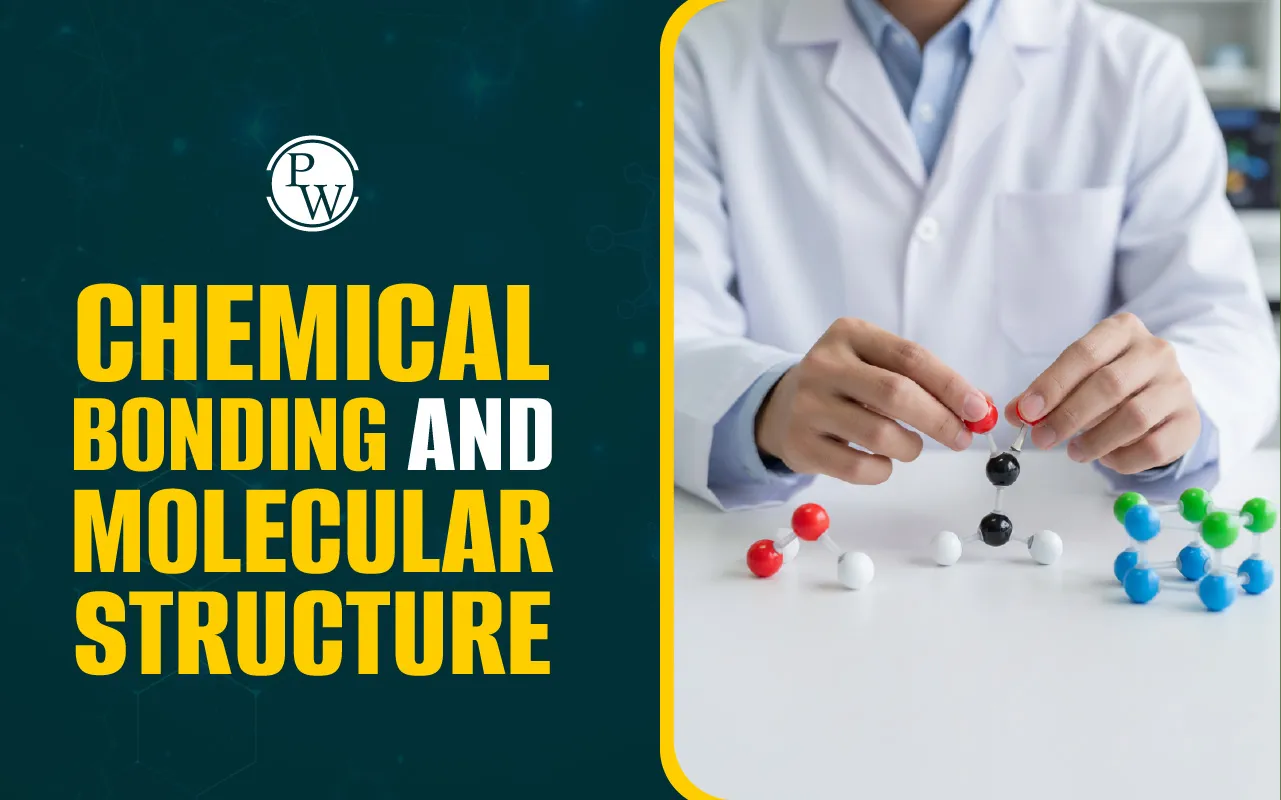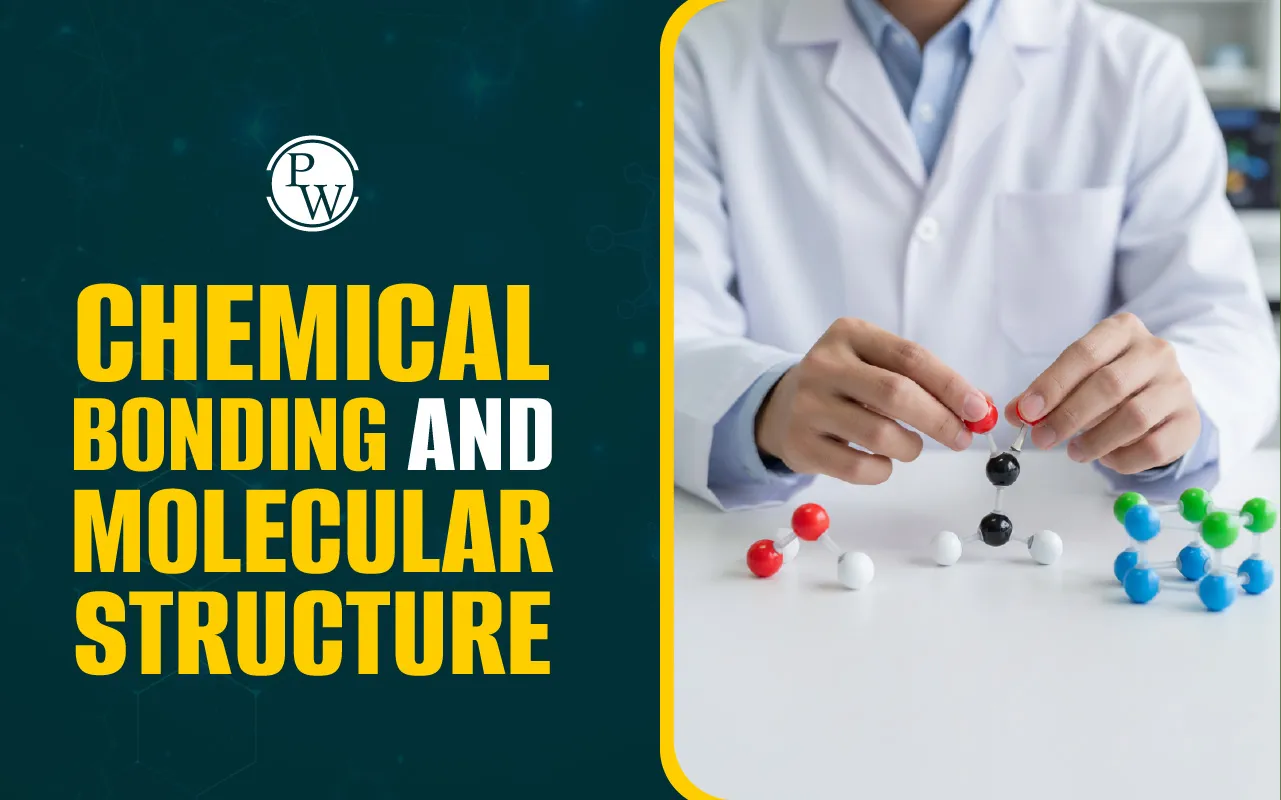

Chemical Bonding and Molecular Structure: Everything present in our surroundings is made up of matter. It includes the air we breathe, the water we drink, and even the human bodies. Matter is made of tiny particles called atoms. These atoms join together to form molecules and compounds.
Chemical bonding explains how and why atoms come together to form different materials. When atoms bond, they create molecules. The way these atoms are linked and arranged in space gives the molecule a unique shape, or molecular structure. This shape decides how the molecule acts and what it can do.
Chemical Bonding and Molecular Structure Overview
Chemical bonding is the force that holds atoms together in a molecule or compound. The combination of atoms forms bonds that become more stable.
-
Atoms achieve such stability by either giving, taking, or sharing electrons. Electrons refer to the tiny, fast-moving particles found in the outer layers of an atom.
-
Some of the types of bonds formed by the atoms are as follows:
-
Ionic Bond: It is formed when one atom gives away one or more electrons completely, and another atom takes them. This creates atoms with opposite electrical charges, like magnets. They are then strongly attracted to each other. Example - Salt (Sodium Chloride).
-
Covalent Bond: It is formed when atoms share electrons. They hold the shared electrons between them, which pulls the atoms together. Example - Water (bond between hydrogen and oxygen).
-
The molecular structure is the fixed way atoms are arranged in a molecule. The structure greatly affects the molecule's properties, such as its boiling point or how it reacts with other molecules.
Also Check:
- NEET Exam Pattern 2026
- NEET 2026 Admit Card
- NEET Eligibility Criteria 2026
- NEET 2026 Exam Centres
- NEET Candidate Login 2026
Chemical Bonding and Molecular Structure Study Material PDF
Chemical Bonding and Molecular Structure are important concepts from which questions are asked in various examinations every year. Candidates can download the Chemical Bonding and Molecular Structure study materials from the table provided below for easy understanding of concepts and practising numerical problems related to it:
| Chemical Bonding and Molecular Structure Study Material PDF | |
| Chemical Bonding and Molecular Structure Study Material | Download PDF |
Lewis Dot Structures
Lewis Dot Structures refer to diagrams representing an element's symbol in the centre and its valence electrons placed around it as dots. It shows the arrangement of valence electrons (outermost electrons) around atoms.
-
These dots represent how atoms share or transfer electrons when forming bonds.
-
We use Lewis dot structures to represent how atoms bond. These were introduced by Gilbert N. Lewis, an American chemist.
-
Each line or pair of dots between atoms shows a bond. A single line means a single bond, two lines mean a double bond, and three lines mean a triple bond.
-
Lewis Dot Structures help in predicting the bonds in a molecule, identify lone pairs (non-bonding electrons), and understand molecular geometry and reactivity.
VSEPR Theory
VSEPR stands for Valence Shell Electron Pair Repulsion Theory. It refers to those electron pairs around a central atom that repel each other and try to stay as far apart as possible.
The VSEPR Theory explains why atoms not only bond randomly, but they also take specific shapes. The basic idea behind the theory is that the bonding pairs and lone pairs of electrons repel one another, and to minimise repulsion, the molecule adjusts its shape. Some of the common molecular shapes according to the VSEPR Theory are as follows:
| Shape | Examples | Bond Angle |
| Linear | CO₂ | 180° |
| Trigonal Planar | BF₃ | 120° |
| Tetrahedral | CH₄ | 109.5° |
| Trigonal Pyramid | NH₃ | 107° |
| Bent (Angular) | H₂O | 104.5° |
Hybridisation Types
Hybridisation refers to the idea that the atomic orbitals of an atom mix together to form a set of new, identical orbitals called hybrid orbitals. These new hybrid orbitals are much better at forming strong, stable chemical bonds than the original orbitals were.
-
The central atom in a molecule needs a set of equally shaped and equally strong orbitals to form equally strong bonds with all the surrounding atoms.
-
The different Hybridisation Types are summarised in the table provided below:
| Hybridisation Types | ||
| Types | Shape | Details |
| sp Hybridisation | Linear |
|
| sp² Hybridisation | Trigonal Planar |
|
| sp³ Hybridisation | Tetrahedral |
|
| sp³d Hybridisation | Trigonal Bipyramidal |
|
| sp³d² Hybridisation | Octahedral |
|
Molecular Orbital Theory
The Molecular Orbital Theory suggests that when atoms come together, their atomic orbitals merge to form molecular orbitals. These new orbitals are spaces where the electrons can move around the entire molecule. When atomic orbitals combine, they form two types of molecular orbitals:
-
Bonding Molecular Orbital (low energy, stable) - These are lower in energy than the original atomic orbitals. Electrons in these orbitals act like glue, holding the atoms together.
-
Antibonding Molecular Orbital (high energy, unstable) - These are higher in energy. Electrons in these orbitals push the atoms apart.
The Molecular Orbital Theory helps in the calculation of bond order. It is the value that provides information about how many bonds are formed (single, double, or triple) and how stable the molecule is.
|
Bond Order = 1/2 (Number of electrons in Bonding Orbitals - Number of electrons in Anti-bonding Orbitals) |
If the bond order is zero, then the molecule cannot exist. The Molecular Orbital Theory is an advanced method that successfully explains things such as why the oxygen molecule is attracted to a magnet (a property called paramagnetism).
Dipole Moment and Polarity
A dipole moment is a measure of the separation of positive and negative charges in a molecule. Not all bonds share electrons equally. Some atoms pull electrons more strongly than others. This uneven sharing creates polarity.
-
When electrons are shared unequally, the molecule develops a positive end and a negative end, like a small magnet.
-
The formula for Dipole Moment is, μ = Q X d, where ‘μ’ refers to dipole moment, ‘Q’ refers to charge and ‘d’ refers to distance.
-
For non-polar molecules, electrons are shared equally with no charge separation.
-
For polar molecules, unequal sharing of electrons creates poles.
-
Dipole Moment explains solubility, molecular interactions, and the strength of hydrogen bonds.
Hydrogen Bonding
A hydrogen bond is a weak attractive force between a hydrogen atom (attached to a highly electronegative atom like oxygen, nitrogen, or fluorine) and another electronegative atom nearby. The conditions for Hydrogen Bonding are as follows:
-
Hydrogen must be bonded to O, N, or F.
-
There must be a lone pair of electrons on the nearby atom.
The different types of hydrogen bonding are explained in the table provided below:
| Types of Hydrogen Bonding | |
| Types | Explanations |
| Intermolecular Hydrogen Bonding |
|
| Intramolecular Hydrogen Bonding |
|
